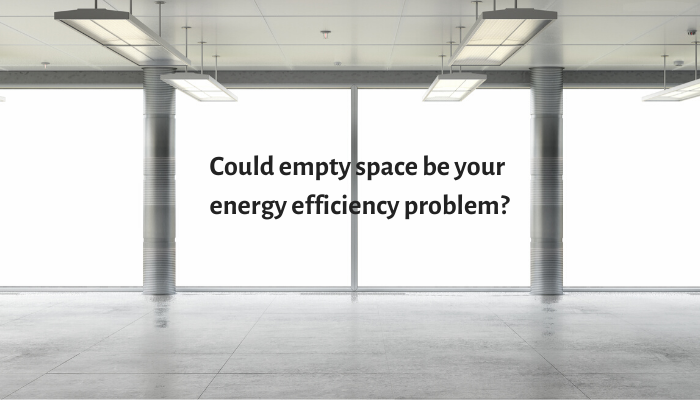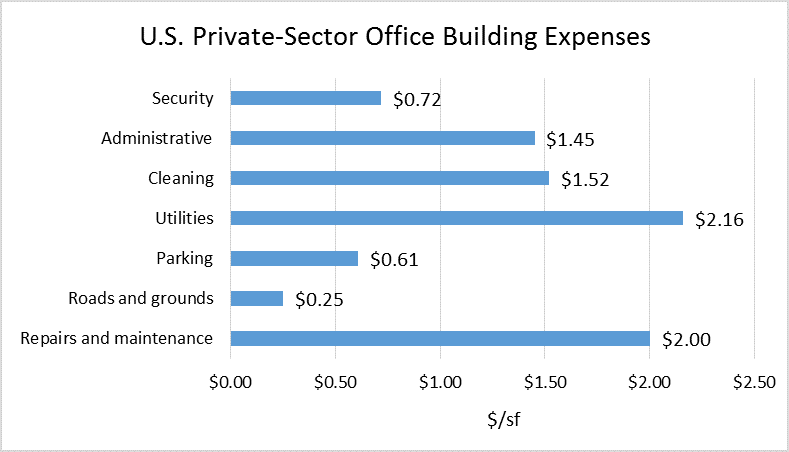The home of smart buildings, smart equipment and IoT

Buildings are expensive assets that require many resources to operate. While the Building Automation industry has been focused on improving energy efficiency and achieving comfort conditions for occupants, there’s another important aspect of facility management that affects both energy efficiency and occupant comfort: space utilization.
For many commercial building operators the energy bill is the largest single expense. If space in your building is not being properly utilized, you’re wasting energy and thus losing money on operating costs. Consider Jones Lang LaSalle’s “3-30-300 rule”, which is a generalisation still works to serve a point. The 3-30-300 rule states that for every square foot of space, the average organization spends: $3 on utilities, $30 on rent, and $300 on payroll. So for every bit of extra, un-utilized space, you’re actually spending $33 extra dollars.

Chart courtesy of BOMA report 2016
Here’s a real world example. Let’s say your business has grown and the business now has 10 buildings in the same area. Great growth! You decide to implement building automation to reduce energy costs and end up reducing your energy usage by 30%. That’s good! But have you optimized all of that space? The average occupancy of commercial offices Is frequently less than 50%. So instead of 10 buildings maybe your organization only needs 6 or 7? If space use has not been optimised then you’re likely to be spending more than necessary on operating costs. Not only more on the energy, but also far more on rent for that extra space, as well as more on the labor required to run that extra space.
The technical advances and cost reduction associated with measuring occupancy have now made space utilization analysis much easier; buildings can be monitored in real-time with statistical reports automatically generated to inform management decisions. If such analysis determines that only 6 of the 10 buildings in our example are required then you are really saving!
In considering how to improve space utilization it is necessary to consider many factors, including capacity, frequency, and purpose.There is some debate as to how utilization should be measured but at its simplest it is workplace occupancy divided by its capacity. While that seems easy enough, the logistics and details are far more complicated. You need to look at the size of your average workstation, the ratio of employees to workstations, how many employees occupy workstations at any given time, as well as conference room usage (frequency, group size, demand, etc.). There’s also a fine line to walk between maximizing space usage and providing a positive work environment. You may be able to save money on energy by cramming occupants into every crevice imaginable, but that will probably create a negative work environment, which can lead to decreased productivity and higher staff turnover, which will increase operating costs. Poor use of space could also lead to collaboration issues, which prevent the development of a strong company culture.
The good news is, it is no longer necessary to wander around the office with a clipboard counting heads and doing math problems to figure out how to best optimize your space. There are a number of IoT technologies that can be incorporated that will help you make better space decisions as you build, grow, and change.
Before you explore space utilization technology, you need to consider offering flexible hours, remote working, and the notion that not everyone needs their own desk.
According to James Lang LaSalle, the average worker only spends 40% of the time at their desk. Why so low? It’s because people are either out on appointments, out of town, working from home, or out sick. The notion that everyone in your office needs their own desk is an outdated concept. Hot desk management is a growing trend in space utilization. Hot Desking, or Activity Based Working (ABW), is a concept where instead of offering dedicated desks for each employee, your desks become shared resources with plenty of workspaces for employees to choose from throughout the office. But how do you know how many desks, huddle rooms, work areas, and conference rooms you need to achieve the right balance? That’s where IoT comes in.
There’s a whole breed of IoT devices on the market that offer space visualization and management tools. Some of these devices use sensors that can detect motion using infrared (PIR) or ultrasonic technology, some use beacons, and some use cameras to identify the number of people in a room at any given time. These devices then transmit the data to occupancy management systems that help facility managers make data-driven decisions on space utilization and design.
Conference rooms are another use of space that can be optimized. Do you need four large conference rooms or will two rooms and multiple huddle rooms suffice? How often do you have people book your conference room and then the meeting gets canceled? How often does a group of four duck into a large room when there are smaller rooms available? How long do employees need to wander the halls looking for available conference room space? IoT sensors and appropriate management software can offer real-time data from meeting rooms to streamline and optimize the use of the space. It can also detect patterns in usage that can inform future decisions on how to use your space. For example, a conference room that is booked but unoccupied could automatically release itself for use by another employee.
Space utilization data is very valuable for facility managers and end-users, and integrating that data with the rest of you BAS is the way to go.
Chris is a J2 Innovations consultant who originally joined J2 in 2018 to develop sales in Europe, the Middle East and Asia. Chris comes with a wealth of experience in the building automation market and skills in strategic business development and marketing. Chris spent 12 years developing Tridium's open framework business in Europe, so he is excited to be now working with the next-generation product. Chris is passionate about simplicity, energy saving, renewable energy, and electric transport.
Topics from this blog: End User
Back to all posts
J2 Innovations Headquarters, 535 Anton Blvd, Suite 1200, Costa Mesa, CA 92626, USA. Tel: 909-217-7040